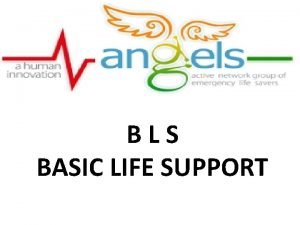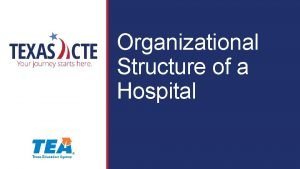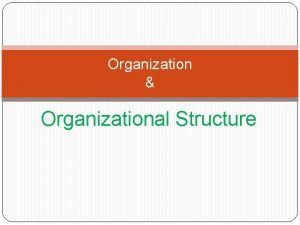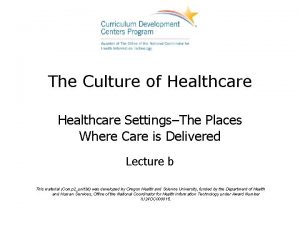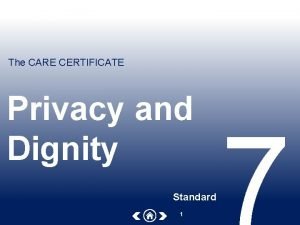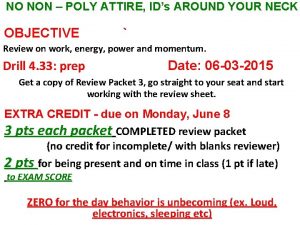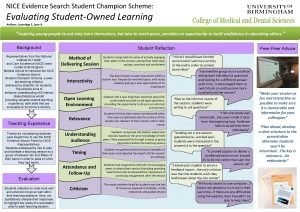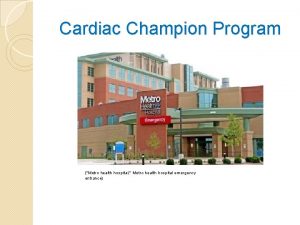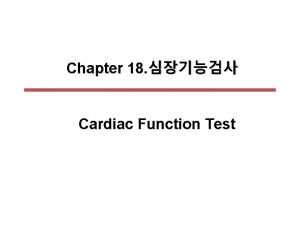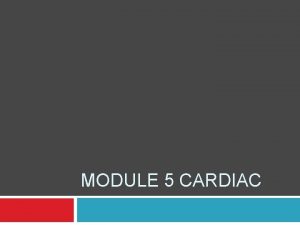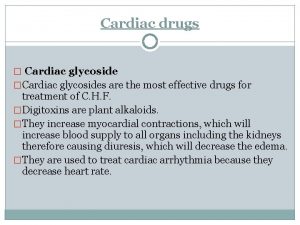Metro Health Hospital Cardiac Champion Program Organizational Strategic



















![References Michigan Department of Community Health [MDCH]. (2009). A vision for Michigan: A strategic References Michigan Department of Community Health [MDCH]. (2009). A vision for Michigan: A strategic](https://slidetodoc.com/presentation_image_h2/9f21aac8651c8b728886490361656bab/image-20.jpg)
- Slides: 20

Metro Health Hospital Cardiac Champion Program Organizational Strategic Plan Ferris State University NURS 440 Leadership in Nursing Kaitlyn Baldwin William Berlin Kelly Jones Oksana Marchenko Rebekkah Mc. Connell Brandi Miller Tracie Strand

Program Background • The Cardiac Champion Program (CCP) is a newly developed cardiac education program at Metro Health Hospital (Metro) in Wyoming, Michigan • 208 -bed general acute-care osteopathic teaching hospital • Serves approximately 130, 000 residents within the area ►This cardiac education program will improve the quality of care for patients and decrease readmissions◄ Provide: Education, Medical Care, Skilled Nursing Population: patients with newly diagnosed and poorly controlled cardiac diseases

Environmental Assessment • Cardiovascular Disease (MDCH, 2009) • Leading cause of death since 1919 • Responsible for 36. 1% of Michigan deaths in 2006 • Cardiac Education Programs • Early rehabilitation is essential to successful outcomes and program compliance (Mampuya, 2012) • Noncompliance increases the chance of disease recurrence and hospital readmission (Yohannes, Yalfani, Doherty, & Bundy, 2007) • One-on-one education prior to discharge decreases readmission rates by 40% or more (Krumholz et al. , 2002; Paul, 2008) • A one-hour nurse educator delivered teaching session prior to discharge results in improved clinical outcomes, increased self-care measures, and reduced cost of care (Koelling, Johnson, Cody, & Aaronson, 2005)

Environmental Assessment • Forces Against Cardiac Education Program • Nursing shortages and financial constraints limit implementation of cardiac education programs (Rothberg, Abraham, Lindenauer, & Rose, 2005) • Regional competition • To compete with Spectrum Health System and Mercy Health Saint Mary’s Hospital, Metro must continue to develop its reputation as a provider of high-quality, patient-centered cardiac care • Centers for Medicare & Medicaid Services (CMS) Hospital Readmissions Reduction Program • Imposes penalties for excess acute myocardial infarction and heart failure readmissions (CMS, n. d. )

Mission In collaboration with our community partners, the mission of the Cardiac Champion Program at Metro Health Hospital is to provide education, medical management, skilled nursing care, and rehabilitation services to community members diagnosed with cardiac disease and to serve as a resource for coordinating specialized, multidisciplinary care.

Philosophy • Responsiveness • Nursing professionals provide patients with the educational tools necessary for successful self-care activities and are responsive to patient questions both during and after discharge. • Patient Centered Education • While the quality of education is uniform, teaching methods may be customized according to patient needs and values. • Communication • Nurses and all other members of the healthcare team work diligently to fulfill the organization’s commitment to sharing knowledge and information with patients. • Collaborative Care • Nurses will work with other members of the healthcare team to ensure quality patient care.

Philosophy • Safety is a top priority at all times and will be enhanced by ensuring patient needs are met during and after discharge and through peer review of nursing practice. • Service • Patient needs should be anticipated whenever possible. • Actively listening to patients and coworkers is essential. • Efficiency • Information should be delivered accurately and in a timely manner. • Teamwork • Nurses will work with other members of the healthcare team to exchange needed information and enhance patient education.

Goals • Provide comprehensive education to patients with newly diagnosed or • • poorly managed cardiac diseases during their hospital admission and after discharge. Develop standardized patient care pathways for patients diagnosed with cardiac diseases focusing on activities of daily living, lifestyle modifications, diet, medications, safety, and pain management. Promote and utilize a multidisciplinary approach to patient care by coordinating between physicians, staff nurses, social workers, home care, and other specialties to facilitate optimal outpatient cardiac disease management. Improve and promote community support for patients diagnosed with cardiac disease. Effectively market the services available through the CCP to the community.

Objectives • To enroll all patients with newly diagnosed heart disease into the CCP prior to discharge. • To provide fundamental, basic cardiac education to CCP participants during each home visit. • To assess the home environment of CCP participants, evaluate and reinforce inpatient teaching at first home visit and thereafter, if needed. • To develop individualized, multidisciplinary patient care plans based on standardized patient care pathways by second home visit. • To educate inpatient and home care nurses annually.

Objectives • To develop comprehensive, web-based resources including an educational database, online support groups, and discussion forums within 90 days of program kick-off. • To facilitate program improvement by soliciting input from CCP participants, healthcare professionals, and community members monthly. • To coordinate CCP activities with ongoing research initiatives monthly. • To develop marketing plans targeting both healthcare professionals and community members within one year of program kick-off.

Organizational Chart Cardiac Champion Program Manager Cardiac Champion Committee Inpatient Clinical Nurse Educator Outpatient Clinical Nurse Educator Nurse Research Liaison Nurse Informatics Specialist

Job Descriptions • Developing job descriptions to define role functions contributes to an organization’s formalization (Mancini, 2011) • To clarify the role of each position within the CCP, detailed job descriptions were written for each position, including: • Program Manager • Inpatient Clinical Nurse Educator • Outpatient Clinical Nurse Educator • Nurse Research Liaison • Nurse Informatics Specialist • As a sample, the job description for Program Manager is included on the next slide

Job Descriptions Cardiac Champion Program Manager Summary Relationships Knowledge, Skills, & Abilities Behavioral Expectations Protected Information Maintaining Competency ü ü ü ü Oversees the entire program Develops a budget and marketing strategy Chairs the Cardiac Champion Committee (CCC) Reports to the Chief Nursing Officer Collaborates with the CCC Supervises all CCP staff BSN or MSN degree Competence in basic cardiac dysrhythmia interpretation 3 years cardiac clinical nursing experience Proficient in computer use Quality leadership ability to develop and maintain good working relationships Strong conceptual skills, with skill in problem-solving, decision-making, & critical-thinking Understanding of performance improvement tools Project management experience ü ü ü ü Supports the mission, vision, & values of the CCP Treats others with respect Fosters a collegial environment Applies ethical codes Attends CCC meetings No direct contact with patients Intermittent access to protected health information of patients ü ü State of Michigan licensure as an RN BLS & ACLS certifications Completion of annual employee training Maintaining certification in cardiac field

Cardiac Champion Committee • Represents a collaboration of experts directly involved in the development and assessment of positive patient outcomes. • Develops standardized patient care pathways while working to improve program elements and hospital readmission statistics by educating the multidisciplinary team to assure best practice. • Uses role specific knowledge to facilitate comprehensive patient education both during hospital admission and after discharge. Functions and Responsibilities: ü Engages and promotes ideas to community ü Collaborates with clinicians to ensure best practice ü Chaired by the Cardiac Champion Program Manager ü Educates staff and implements changes within department ü Attends at least 10 monthly meetings within the fiscal year ü

Advertisement

Budget Proposal • An initial budget was proposed and then cost conscious strategies were implemented to develop a final one year budget for the CCP. • Total expenses are projected at $248, 740 and total project funding is estimated to be $339, 610. • Costs include salaries, benefits, supplies, and operating expenses. • Project funding will be generated from insurance revenue and other operating revenues produced by penalty and readmission savings. • By reducing readmissions, the program will save an estimated $74, 000 in CMS penalties and $220, 000 in costs to treat readmitted patients. • Profit is necessary to replace broken and outdated facilities and equipment, expand services, and pay for inflation costs (Stafford, 2011).

Cost Conscious Strategies • Consolidated program roles using hospital resources, reducing salary costs by $14, 020. • Researched specific costs of office supplies, educational materials, and operating expenses, cutting program expenses by $49, 400. • Salary budgets for each position are: • Program manager (0. 5 FTE) - $29, 690 • Inpatient clinical nurse educator (1. 0 FTE) - $66, 980 • Outpatient clinical nurse educator (1. 0 FTE) - $66, 980 • Nurse research liaison (0. 25 FTE) - $14, 590 • Nurse informatics specialist (0. 25 FTE) - $14, 900 • In addition to these salaries, the budget for benefits was calculated to be $24, 000 based on a total of three FTEs at a cost of $8, 000 per FTE (Adeyanju, 2013). • While not all positions will be full-time, they will likely be filled by full-time employees who are job-sharing with other roles and thus will include benefits.

Budget Proposal Comparison First budget proposal yielded a profit of $27, 450 Final budget proposal yielded a profit of $90, 870 Program Costs Salary $205, 160 Salary $193, 140 Benefits $26, 000 Benefits $24, 000 Supplies and operating expenses $81, 000 Supplies and operating expenses $31, 600 Total Program Costs $312, 160 Insurance revenue Total Program Funding $248, 740 Program Funding Other operating revenue Total Program Costs $294, 000 $45, 610 $339, 610 Other operating revenue Insurance revenue Total Program Funding $294, 000 $45, 610 $339, 610

References Adeyanju, R. O. (2013). Syllabus for NURS 440 leadership in nursing. (Available from the Ferris State University School of Nursing, 200 Ferris Drive, Big Rapids, MI 49307) Centers for Medicare & Medicaid Services [CMS]. (n. d. ). Readmission reduction program. Retrieved from http: //www. cms. gov/Medicare-Fee-for-Service. Payment/Acute. Inpatient. PPS/Readmissions-Reduction-Program. html Koelling, T. M. , Johnson, M. L. , Cody, R. J. , & Aaronson, K. D. (2005). Discharge education improves clinical outcomes in patients with chronic heart failure. Circulation, 111, 179 -185. doi: 10. 1161/01. CIR. 0000151811. 53450. B 8 Krumholz, H. M. , Amatruda, J. , Smith, G. L. , Mattera, J. A. , Roumanis, S. A. , Radford, M. J. , . . . Vaccarino, V. (2002). Randomized trial of an education and support intervention to prevent readmission of patients with heart failure. Journal of the American College of Cardiology, 39, 8389. doi: 10. 1016/S 0735 -1097(01)01699 -0 Mampuya, W. M. (2012). Cardiac rehabilitation past, present, and future: an overview. Cardiovascular Diagnosis and Therapy, 2, 38 -49. doi: 10. 3978/j. issn. 2223 -3652. 2012. 01. 02 Mancini, M. E. (2011). Understanding and designing organizational structures. In P. S. Yoder-Wise (Ed. ), Leading and managing in nursing (5 th ed. , pp. 137 -156). St. Louis, MO: Elsevier Mosby.
![References Michigan Department of Community Health MDCH 2009 A vision for Michigan A strategic References Michigan Department of Community Health [MDCH]. (2009). A vision for Michigan: A strategic](https://slidetodoc.com/presentation_image_h2/9f21aac8651c8b728886490361656bab/image-20.jpg)
References Michigan Department of Community Health [MDCH]. (2009). A vision for Michigan: A strategic plan for heart disease and stroke – 2009 -2014. Retrieved from http: //www. michigan. gov/documents/mdch/HDS_Strategic_Plan_9_09_333778_7. pdf Paul, S. (2008). Hospital discharge education for patients with heart failure: What really works and what is the evidence? Critical Care Nurse, 28(2), 66 -82. Rothberg, M. B. , Abraham, I. , Lindenauer, P. K. , & Rose, D. N. (2005). Improving nurse-to-patient staffing ratios as a cost-effective safety intervention. Medical Care, 43, 785 -791. Stafford, T. B. (2011). Managing costs and budgets. In P. S. Yoder-Wise (Ed. ), Leading and managing in nursing (5 th ed. , pp. 228 -248). St. Louis, MO: Elsevier Mosby. Yohannes, A. M. , Yalfani, A. , Doherty, P. , & Bundy, C. (2007). Predictors of drop-out from an outpatient cardiac rehabilitation programme. Clinical Rehabilitation, 21, 222 -229. doi: 10. 1177/0269215506070771
 Adult chain of survival
Adult chain of survival National programmes related to child health and welfare ppt
National programmes related to child health and welfare ppt Housekeeping organizational structure
Housekeeping organizational structure Private limited company organizational structure
Private limited company organizational structure Itani pharmacy
Itani pharmacy What is the organizational structure of a hospital
What is the organizational structure of a hospital Healthcare organizational chart
Healthcare organizational chart Organization of hospital pharmacy
Organization of hospital pharmacy Strategic fit vs strategic intent
Strategic fit vs strategic intent Strategic complement
Strategic complement Io model strategic management
Io model strategic management Tows matrix
Tows matrix Care certificate privacy and dignity
Care certificate privacy and dignity Maya angelou champion of the world
Maya angelou champion of the world Project champion
Project champion Haloke does 176 j of work
Haloke does 176 j of work Nice student champion
Nice student champion Club champion financing
Club champion financing Rizal carved the image of the blessed virgin mary on a
Rizal carved the image of the blessed virgin mary on a Champion challenger estrategia
Champion challenger estrategia Champion of the common man
Champion of the common man
